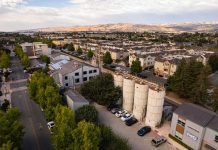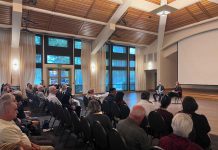It had to do with my wife’s and my legacy. Somehow, I had to show our daughter, our executor, and her husband where our property was located in the wilderness of Oregon. They had the time and inclination. Our other three sons didn’t.
Geographically, Imnaha is in the very northeast corner of the Beaver state.
In the past, we had driven to Imnaha via La Grande, Oregon. We continued to Enterprise. Nevertheless, to reach Imnaha on State Highway 82, the traveler must take a meandering drive, leading 50 miles away from Enterprise; Safeway, hospitals and civilization. Little Imnaha is in the boondocks of northeast Oregon.
This time, however, we drove the California back way, up Highway 395, through Lakeview, Ore. to Baker City, then to Halfway to Hells Canyon Overlook (overlook to Idaho) and onto the Imnaha gravel forestry road.
Get your Atlas out, now, and find it. Look for the Wallowa-Whitman National Forest.
Our destination is Imnaha River Woods and our two lots, half acre each, on the river, some 25 miles up the river valley toward the headwaters.
Back in 1967, my wife’s father purchased the prime property. Prime because it bordered a bend in the Imnaha River. Prime for fishing. Prime for a “get-away” cabin. The developers of Imnaha River Woods sponsored an all out sales extravaganza, touting the property as the “undeveloped west” to the citizens of burgeoning Southern California. Actually, they did bulldoze roads (most now totally overgrown) and supplied electric power boxes to trees on the two lots Dad purchased on designated Salmon Way. How provocative, Salmon Way. (fishing, fishing) Water to your homesite was up to each property owner. (But, few southern Californians ever built and most of Imnaha River Woods development has reverted to forest. Yet, a few large homes snuggle into the trees and some residents live there the year around.
Last time we went, a week after 9/11 on the Monday after, we entered two-rutted Salmon Way and immediately our mini-van got stuck in the mud. Fortunately, a neighbor pulled us out and we followed his ATV to our property, on foot. The almost acre of land appeared grassy, but clear with trees bordering the river.
Imnaha Canyon Day, celebrated Saturday, Sept. 15, in 2001, included one of the most unusual feeds in the world; a high-spirited parade, in which locals try to out-do each other in the costume category; and an old-fashioned western horse playday, barbecue and dance.
The main course of the Imnaha Bear and Rattlesnake BBQ, as the name suggests, is bear and rattlesnake meat, served up with large portions of Imnaha-grown garden vegetables. The bear is donated by local hunters, as is the snake–there is a running tally of the number of snakes killed every year by locals posted at the Imnaha Store and Tavern which hosts the popular feed. The fare, nine bear and almost 200 rattlesnakes.
When you get to Imnaha, you can stop by the store, where wooden Indians repose on the front porch and cafe booths take up the center of the wood-floored grocery, cafe and beer bar. Look down the road at the small school house, too. Nearby, the one room post office sorts and delivers mail three days a week.
The Imnaha Store – 30 miles northeast of Joseph and 24 miles from Hat Point and the deepest gorge in the North American continent named Hells Canyon – is the last store on that segment of the planet. It sits within a stone’s throw of the Imnaha River in the town of Imnaha which, at last count at the recollection of store owner David Tanzey, had a population of 18 people.
Next to the store, the gravel road turns south upstream to follow the Imnaha River, through a dazzling river valley where ranches are rimmed by steep hills and where cattle, rattlesnakes and sometimes bear roam. Actually, the Imnaha river runs north into the Snake river.
This time, we came in from the south on the forestry road. The Salmon Way signs were still attached to the two trees at each side of the entrance. But, within 50 feet the two ruts became overgrown. Fortunately, we had brought tree trimmer clippers and began cutting back the trees and bushes. Following the ruts, our son-in-law went before us, cutting away. Nevertheless, we had to go fast through the mud to a dry area where we turned around and headed out, then parked. The ruts had become impassable so we continued on foot.
Although we carried a loud air driven boat horn as well as a container of tear gas for bears and rattlesnakes in the heavy undergrowth, the situation became too dangerous. We had come to the “fairly cleared” property perhaps five times in the last 20 years and could always get to it by driving or walking. This time the undergrowth prevented us from recognizing the parcel. Our son-in-law proceeded along the ruts the furtherest, but we don’t know if he got to the property or not.
Accompanying us grown-ups was our 6-year-old granddaughter. When her grandmother, father and mother, disappeared into the undergrowth, we called out. Strangely, they could hear us, but we could not hear their yelled answers. So, she and I were alone in the wilderness.
Staunchly, recognizing the apparent awful truth, she said, “Well, my family now consists of three, my Grandma, Grandpa and me.”
I said, “Well, what about me!”
“Oh, you, too, Grandpa.”
Fortunately, they all returned to the car and our son-in-law gunned our “all-wheel drive” through the deep-rutted mud, back to the safety of graveled forestry roads.
Traveling north some 25 graveled miles, we came to the little town of Imnaha. We had lunch, there. The Imnaha Store was the same as always, except the “Bear and Rattlesnake Feed” had been discontinued some two years before.
Tanzey, the owner, said, “It just got to be too much.”
However, they still have posted on their wall an article about their Imnaha Store by Herb Caen in “The San Francisco Chronicle,” that we brought some 20 years ago.
So, our property is absolutely overgrown. Maybe, we have to hire a bulldozer to clear Salmon Way and our property. Maybe, we let our executor, our daughter, and husband decide what to do with the property.
Perhaps, that’s what happens, as you grow older.
Incidentally, our all-wheel-drive Mercury Mountaineer SUV, traveled 2219 miles on this trip, averaged 21 miles per gallon. We used approximately 110 gallons for about $312. Highest gas cost at $3.199 at Bella Vista, Hines, Ore. and Redding. Lowest price was $2.999 at Veneta, Ore.
As a post script, we traveled to Vancouver, Wash. Then, our daughter, son-in-law, and grand daughter flew home from Portland, Ore. My wife and I vacationed on the beach at Bandon, Ore.
Experiencing the past and pondering the future, that’s life.
Burton Anderson, a U.S. Marine veteran of the Koean War, has lived in California for about 50 years. He has a background in aerospace industry. He can be reached at ba****@*ol.com.







